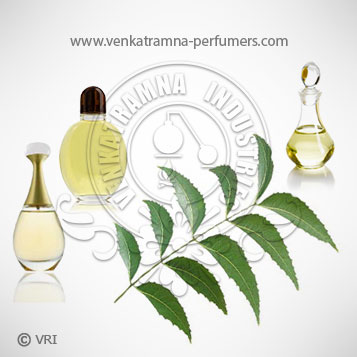
| Botanical Name | Azadirachta indica |
| Common Name | Neem, Nimba. |
| Country of Origin | India |
| Solubility | Insoluble in water, soluble in alcohol and oils |
| Specific Gravity | 0.893 @ 72°F |
| Optical Rotation | >170C |
| Refrective Index | 1.479 @ 72°F |
| PlantPart | Seed |
| Bland With | Geranium, cedarwood, florals, sandalwood. |
| CAS No | 8002-65-1 |
| Flash Point | 89°C |
| Extraction Method | Cold Pressed |
Neem Oil is taken from Neem Tree (Azadirachta Indica) that is a native of India. It is a evergreen tree of moderate height and have crescent shaped toothy leaves & large growth of white flowers. The extract is well acknowledged to be an effective & environmentally friendly source as pest inhibitor as well as in form of tonic as it has astringent, antipergative & antiseptic properties. Neem tree has been widely planted as a shade tree in hot, drought prone areas and has over time been introduced to tropical areas around the world. Interesting container plant for indoors.
The medicinal properties of the neem tree have been well known in the Indian subcontinent for thousands of years. A symbol of health, the hardy, evergreen tree is a common feature of the drier regions of India and Pakistan. The bark, leaves, flowers, seeds and fruit are used to treat a number of diseases and the tree had a cherished place in all ancient Indian treatises on medicine. Azadirachta indica, commonly called neem tree or margosa tree, is native to tropical, dry, deciduous/evergreen forests of Burma, India and Ceylon (now Sri Lanka), but has for many years been cultivated throughout India, Malaysia and Pakistan. It is a medium sized tree that grows to 50-75' (less frequently to 100') tall with a dense, round to oval crown. It is evergreen but may temporarily lose its leaves in protracted drought conditions. Compound pinnate leaves (6-12") have 8-18 serrated medium to dark green leaflets (each to 3" long). White fragrant flowers in drooping panicles to 10" long bloom in spring. Trees are polygamous (both bisexual flowers and male flowers exist on the same plant). Edible fruit is a smooth olive-like drupe. Each fruit contains one (rarely 2-3) elongated seeds. Neem trees are sacred in their native land. Almost every part of the tree has some uses. Durable wood (mahagony family) is used for furniture and lumber. Leaves and bark are used in teas, cosmetics, toothpaste, pet care and medicinal preparations. Dried leaves are used to deter moth. Twigs are used as tooth brushes. Neem oil is a broad spectrum botanical insecticide, repellent and fungicide. It is also used for a variety of additional purposes including machinery lubricant, lamp fuel and for soaps and cosmetics. Neem cake is used as a fertilizer and a nematicide.
Color : Light yellow transparent liquid @22C with Characteristic of Neem fragrant odor,
Aroma : Peanut and garlic
Azadirachtin, Nimbidinin, Nimbin, Nimbolides. Triterpenes more specifically, limonoids such as azadirachtin, salannin, meliantriol, nimbin, nimbidin, meliantriol, deacetylazadirachtinol, salannin, salannol, 3-deacetylsalannin etc.
A bitter tonic, is has astringent, antipergative and antiseptic properties and is used in ulcers & eczema, skin diseases as well as in treating rheumatism. The plant product or natural products show an important role in diseases prevention and treatment through the enhancement of antioxidant activity, inhibition of bacterial growth, and modulation of genetic pathways. The therapeutics role of number of plants in diseases management is still being enthusiastically researched due to their less side effect and affordable properties. It has been accepted that drugs based on allopathy are expensive and exhibit toxic effect on normal tissues and on various biological activities. It is a largely accepted fact that numerous pharmacologically active drugs are derived from natural resources including medicinal plants. Azadirachta indica has complex of various constituents including nimbin, nimbidin, nimbolide, and limonoids and such types of ingredients play role in diseases management through modulation of various genetic pathways and other activities. Quercetin and ß-sitosterol were first polyphenolic flavonoids purified from fresh leaves of neem and were known to have antifungal and antibacterial activities. Numerous biological and pharmacological activities have been reported including antibacterial, antifungal, and anti-inflammatory.